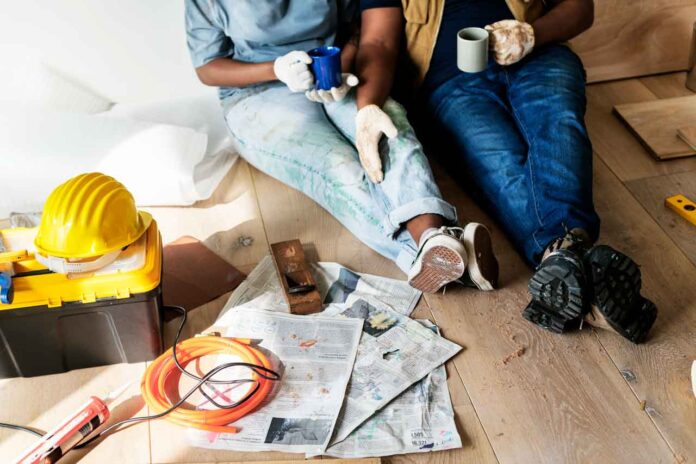Removing popcorn ceiling texture is an excellent way to improve the surface’s appearance. Although the process is messy and time-consuming, it can be a rewarding home improvement project with the right preparation and the proper tools. Let’s analyze the popcorn ceiling removal features and main stages.
Some words about a popcorn ceiling
A popcorn ceiling is an uneven surface that resembles plaster. Typically, it is created from a sealant (plaster mass) or sprayed texture. Today, such surfaces are considered an outdated design element, as they accumulate dust and often develop difficult-to-remove stains. Their initial popularity is due to good soundproofing properties. This is relevant for corridors and hallways with high traffic and rooms with high ceilings where echo occurs. It is also a quick and cheap option to hide surface imperfections.
Remember, old popcorn ceilings can be a health hazard. They often contain asbestos or lead. Before removing such a covering, a special kit must be used to test a small area for hazardous substances. If the test confirms the presence of such compounds, a trained professional should do the removal work.
Why should you get rid of a popcorn ceiling?
There are several reasons why people want to get rid of a popcorn ceiling.
- Improved appearance. A smooth or barely noticeable textured surface makes a room look more spacious and stylish.
- Easy to maintain. Popcorn ceilings actively collect dust and can be difficult to clean later.
- Optimal lighting. Smooth surfaces effectively reflect sunlight, filling the room with light.
- Increased property value. New ceilings can be an argument for selling a house at a higher price.
You can use more modern finishes such as wooden beams, painted patterns, or coffered ceilings. When choosing a finish, consider the style of the decor and your budget.
Basic steps to remove a popcorn ceiling
Many homeowners today are considering removing a popcorn ceiling independently. Before you begin the project, assessing the basic steps to remove this texture is essential.
- Prepare the space. Remove all furniture from the room. Cover the walls and doorways with plastic film. Remember to cover electrical outlets and vents. If there is a chandelier, remove or cover it with plastic film. Since the work is being done in a humid environment, the power supply must be turned off.
- Spray the product. Use a convenient spray bottle to dampen the surface. Do not soak it too much so as not to damage the drywall. It is better to work in limited areas, measuring four by four feet.
- Remove the finish from the ceiling. After spraying a limited area with warm water, you can begin cleaning. Hold the tool at an angle and remove materials, working in straight lines to preserve the surface underneath. Repeat in four-foot by four-foot sections until the ceiling is smooth.
- Get rid of dents. Once you have removed the old coating from the entire surface, use a putty knife to fill the uneven areas with spackle or caulk.
- Sand the treated areas. Sand down everything you have filled in and any other uneven areas on the ceiling to smooth the surface.
- Paint the finished surface. Depending on the paint you choose, you may use a thick coat of primer before you begin. However, innovative products in stores contain both paint and primer. Pour a small amount of paint into a convenient tray. Use an angled brush to paint the areas where the ceiling meets the walls. Then, use a roller to apply the paint. Let it dry before using additional layers.
Getting rid of popcorn finishing can give your space a new look. Following the steps above, you can refresh the surface quickly. Stock up on all the necessary tools and work as soon as possible.





